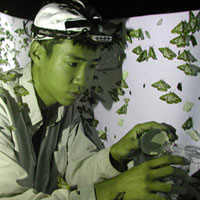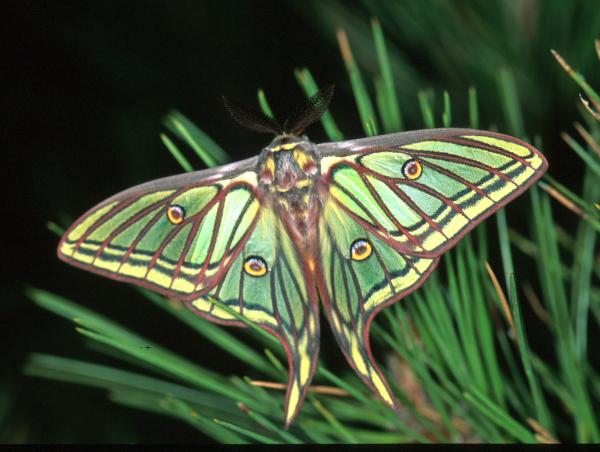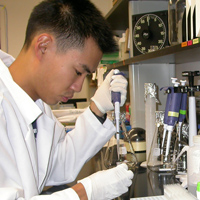
Meet Our Graduate Students
Akito Kawahara still uses the butterfly net that his father gave him when he was four years old, though his insect collection and classification techniques have undoubtedly advanced. Kawahara is a PhD candidate in the University of Maryland Department of Entomology, College of Chemical and Life Sciences. Following his Childhood Bliss Responding to the Biodiversity Crisis Akito came to the University of Maryland for his PhD research because of the strong interdisciplary collaborations between departments and colleges and the ties to nearby institutions. “We’re going through a biodiversity crisis right now and many things are going extinct. There aren’t enough researchers in insect taxonomy and systematics, and I feel really strongly about the urgency of what we have to classify and discover,” he explains. Unraveling how Moths and Plants Evolved Together Kawahara has traveled to parts of the world including Chile, Congo, Costa Rica, Malaysia, and Taiwan to collect and classify Lepidoptera. His dissertation research focuses on a particular group of Lepidoptera known as leaf-mining moths, whose caterpillars live inside the layers of a leaf and carve out “mines” or small pathways. He is interested in how they evolved with certain plants because many fossils of leaves have the leaf-mining moth patterns. He will test the correlation using the fossils to date the tree, molecular and morphological data, along with a technique called “DNA barcoding.” Kawahara conducts his molecular work in Dr. Jerome Regier’s laboratory at the UM Biotechnology Institute, which works closely with The Canadian Centre for DNA Barcoding (CCDB) to enable the rapid identification of existing species from DNA samples. Kawahara’s research focuses on South America where only 161 of the more than 2000 species of leaf mining moths there have been described. With the help of his co-advisor at the Smithsonian Institution, Dr. Donald Davis, a specialist in these moths, and the Canadian barcoding group, Kawahara can determine whether he has found a new species, and if so, go about the process of naming and characterizing it. Growing the Tree of Life In addition to his doctoral research, Kawahara is involved in the Tree of Life project, an international collaborative project funded by the National Science Foundation that seeks to understand the evolutionary relationships of all living organisms. His advisor, Dr. Charles Mitter, is one of the Principal Investigators on the project (www.leptree.net). “Through this research, we can answer questions about evolutionary biology and explore the deeper relationships of Lepidoptera,” Kawahara says. Kawahara, Mitter and other colleagues from UM, along with collaborators from the Smithsonian, Europe, and throughout the world, are on a mission to catalogue the DNA of the Lepidoptera they collect in the hope of adding to the tree of knowledge about the more than 150,000 known moth and butterfly species. “There are many more that remain undiscovered,” Kawahara says. The specimens are often sampled in remote rainforest areas that researchers sometimes travel days to reach. Once there, they set up generators and mercury vapor lamps at night to attract insects. “You see all sorts of things, in addition to butterflies and moths, bats come in to eat the insects and frogs too,” Kawahara explains excitedly. “You see an amazing diversity, and come to really appreciate nature. I love it.” Out of thousands of insects that appear, they collect only those that they are permitted, and necessary for the research. In Dr. Regier’s laboratory, Kawahara extracts the DNA, which is stored in a minus 80 degree freezer. Kawahara also works closely with Dr. Michael Cummings’ Laboratory of Molecular Evolution at the University of Maryland’s Center for Bioinformatics and Computational Biology. Dr. Cummings’ research group helps analyze the DNA using a network “grid” of thousands of computer processors. The data are then made available to researchers throughout the world. After he completes his PhD, Kawahara plans to pursue a professorship and continue his research on many continents. He feels grateful to his parents who enabled him to benefit from a bilingual and bicultural upbringing which he feels was key to his interest in entomology. Recently, he was able to thank his father in an unusual but apt way – he named a moth after him. Visit Dr. Mitter's website or Akito Kawahara's website for more information.
|
[an error occurred while processing this directive]
![]()
| Prospective Graduate Students |
College of Chemical & Life Sciences * University of Maryland * College Park, MD 20742


